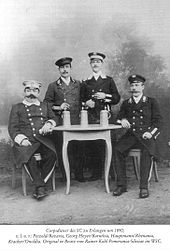Fax (student union)

The fax (also Couleurdiener or Corpsdiener ) has been an employee of the association since the 1880s, helping the students with housekeeping , beer supply , drumming and measuring . The term fax probably goes back to factotum .
tasks

Faxes were employed by connections since the 1860s, initially usually not yet full-time. In the time before the establishment of the corporation houses , the main tasks of faxing lay in the procurement of drinks and in the care of the drum kit and the students' fencing weapons .
When the associations built their houses towards the end of the 19th century, the scope of duties was expanded to include janitorial and housekeeping activities, with mostly female employees. Often the fax lived with his family in the corporation house.
A particularly important and responsible task of the fax machine was putting on protective equipment for the scale length . During student fencing, she ensures that no fatal accidents occur. Proper investment requires experience and skill. At the time, the students blindly trusted their faxing, which often came from the craft sector and sometimes worked for the connection for decades. From Würzburg it is known that a fax served a connection for 39 years. Theodor Angstmann was 54 years with the Corps Saxo-Borussia Heidelberg .
Occur

Faxe also wore a couleur hat at least until the 1930s . This looked roughly like the lady's cap of the respective connection, but was significantly larger (like that of a service man at the train station at the time) and had a circle of connection in gold or silver (depending on the percussion color ) above the metal umbrella . In addition, there was often a livery , the design of which was based on the bar jackets of the supervised students, but had a longer cut.
Sometimes faxes also developed a certain sense of class. There are color photos from the Weimar Republic or the German Empire, on which the faxes of all local corps pose together in hat and livery in front of the camera. They were also in their own association, the Bund der Couleurdiener Deutschlands e. V. based in Halle (Saale). The federation was subdivided into individual local groups and temporarily published its own publication, the magazine Der Couleurdiener . Before the Second World War, Allianz offered its own Couleurdiener insurance, which was intended for the retirement of the Faxen. The associations of the corps, fraternities, country teams and gymnastics associations organized their own couleur servant support fund.
Pohnke, Masovia (1928)
Theodor Angstmann, 1907–1961 with Saxo-Borussia
Today's staff
Today the mentioned tasks in the areas of gastronomy and housekeeping are mostly performed by a woman or a married couple who often live in a granny flat of the corporation house. However, only financially strong connections can afford a fax or a housekeeper. Many connections, however, are too small for faxing. The beverage supply is then usually taken care of by a beer keeper, the management of the house by a caretaker. Both can come from the activitas or the old rulers. The competencies are distributed differently depending on the federal government.
Individual evidence
- ^ A b Friedrich Schulze, Paul Ssymank : The German student body from the oldest times to the present . 4th edition. Verlag für Hochschulkunde, Munich 1932, p. 438.
- ^ Robert Paschke : Fax. In: Friedhelm Golücke : Student History Lexicon . SH-Verlag 1999, ISBN 3-89498-072-9 , p. 105.
- ↑ Torsten Lehmann: The Hallenser Corps in the German Empire: an investigation into student liaison from 1871 to 1918. Mitteldeutscher Verlag , Halle (Saale) 2007, p. 152.
- ↑ Peter Krause : O old lad glory. The students and their customs. 5th edition. Graz / Vienna / Cologne 1997, p. 175.



